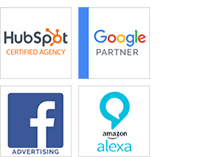
How AI Marketing Effects SEO
For years, artificial intelligence (AI) was mere science fiction — an idea with unlimited possibilities. As technology has advanced, AI has developed to the point where it’s not only implemented throughout our everyday lives, but it’s become so commonplace that it’s beginning to be taken for granted. For example, virtual personal assistants, such as Siri and Alexa, movie recommendation services, and smart cars are all known quantities.
One area in which AI is currently upheaving the status quo is in the online marketing world. The emergence of AI marketing over the past few years is already changing the way businesses market their brands — and for the better.
How AI Has Affected SEO
Traditionally, search engine optimization (SEO) was based on a handful of factors, from keyword use to link building. Google and other search engines would use algorithms to rank content based on these factors. However, the introduction of marketing AI has changed the way Google is able to rank content. AI marketing software allows for the collection of valuable user and website data and analysis in real time. Take for example Google’s RankBrain.
Google introduced its RankBrain AI marketing software a few years back with the aim of more accurately identifying high-quality, relevant content for its search engine users. It has become their third most important ranking factor in their overall algorithm. It works by being able to accurately analyze queries in real time and returning relevant search results even if the exact keyword phrase used in the search doesn’t appear in the content. It does this by scanning website content and identifying related terms and concepts that make it relevant to the query. This means that there no longer needs to be an emphasis on forcing keywords into your content to make sure that Google identifies what your content is.
The use of marketing AI has also ushered in the ability to perform voice searches. Consumers are increasingly using voice search features via their virtual personal assistants, such as Alexa, to find what they are looking for. One of the reasons voice search is possible is because of how advanced AI marketing software is able to determine context without specific keywords. As a result, you will need to focus more on user intent in order to position yourself to be found by voice search. Fortunately, you can use AI software to collect and analyze user data and website data in order to identify what that user intent is.
The Future of AI Marketing
Considering how marketing AI has already changed the SEO landscape over the past few years, it’s not difficult to predict that there’s going to be even more change on the way. The following are a few ways in which marketing AI is likely going to change the way you market your brand in the near future:
No more keywords
RankBrain has already shown that AI is advanced enough to be able to infer meaning from certain words to help supply its queries with relevant content. AI is only going to get smarter in the future, which means soon enough, it will be able to scan content and determine relevance to user queries without having to identify specific keyword phrases or phrases that are similar to those used in queries. This will become even more necessary as voice search becomes more prominent since while users have been trained to perform searches using keywords, they rarely speak naturally using keyword phrases. This means that instead of competing with keywords, you’ll have to focus on just creating good content that is relevant to your audience, thereby placing even greater importance on your audience’s user intent.
Deep user intent
When you look at some of the more popular websites that rank high on Google’s SERP, it’s not uncommon to see sites like IMDB or Wikipedia. One of the reasons for this is not only because they provide high-quality content relevant to a lot of user queries, but they have a lot of supporting content as well that users continue to read, resulting in visitors staying on their sites for a longer time. This means that when identifying user intent, you’re going to have to take a more holistic approach to the buyer’s journey by considering every stage. By creating content based on user intent at every stage of the buyer’s journey, visitors will be more likely to stay on your site and look through more pages. There’s no doubt that in the near future, AI will begin taking into account how websites address the intent of visitors at every stage with its supporting content.
Automated content creation
Keeping in mind how advanced AI is likely going to be able to identify high-quality, relevant content based on the entirety of the content and not just a handful of keywords, it’s not that far of a stretch to predict that AI software will soon be able to create content for businesses as well. Right now, AI-created content reads like it was produced by a robot — but many believe that it will be able to create natural sounding content in the near future.
The use of AI marketing has already begun to improve the quality of search for users around the world. It’s never been easier for people to find what they’re looking for. Although you will need to adapt to the growing impact that AI is having on the inbound marketing world, doing so shouldn’t be difficult. As long as you focus on creating high-quality content for your target audience, you will find it much easier to adapt than those who were solely focused on earning high search rankings.

























